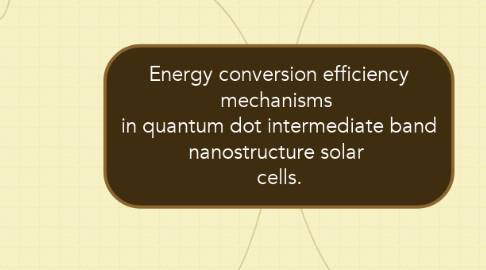
1. Quantum dot solar cells
1.1. The two fundamental pathways for enhancing the conversion efficiency (increased photovoltage) or increased photocurrent can be accessed in principle, in three different QD solar cell configurations.
1.1.1. Quantum dots inserted in p-i-n cells
1.1.1.1. Inserting QDs as 3D arrangement into a 1D-superlattice p-i-n structure with a suitable small distance between the QD layers leads to strong electronic coupling and produces minibands named as intermediate band for producing long-range electron transport
1.1.2. Nanocrystalline TiO2 solar cells sensitized by Quantum Dots
1.1.2.1. Possible advantages of QDs over dye molecules are the tenability of optical properties with size and better heterojunction formation with solid hole conductors.
1.1.2.2. A unique capability of the QD-sensitized solar cell is the production of QY greater than one by impact ionization this capability produces higher conversion efficiencies than dye-sensitized solar cells.
1.1.3. Quantum dots dispersed in conducting polymers
1.1.3.1. The structures consisting of the dispersed QDs in a blend of electron- and hole-conducting polymers have shown PV effects. In this structures, a disordered array of CdSe QDs is formed in a hole-conducting polymer-MEH-PPV
2. Multiple Exciton Generation
2.1. 1. Shockley and Queisser efficiency is accessible in semiconductors with bandgaps ranging from about 1.25 to 1.45 eV
2.2. 2. Solar spectrum contains photons with energies ranging from about 0.5 to 3.5 eV
2.3. 3. Energies above the bandgap charge carriers (electrons and holes) with a total excess kinetic energy equal to the difference between the photon energy and the bandgap will produce
2.3.1. Such carriers are named as hot electrons and hot holes.
3. Intermediate-band sollar cells
3.1. IB solar cells are based on intermediate band materials.
3.1.1. These materials are characterized by the existence of an intermediate band located between the conventional semiconductor conduction band (CB) and valence band (VB)
